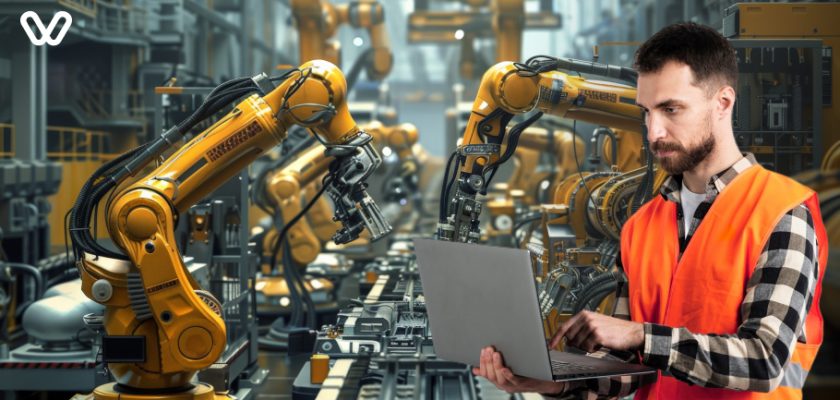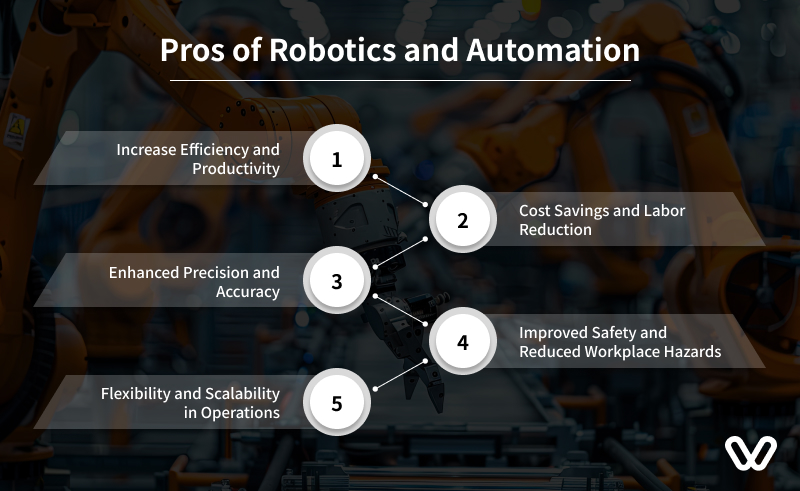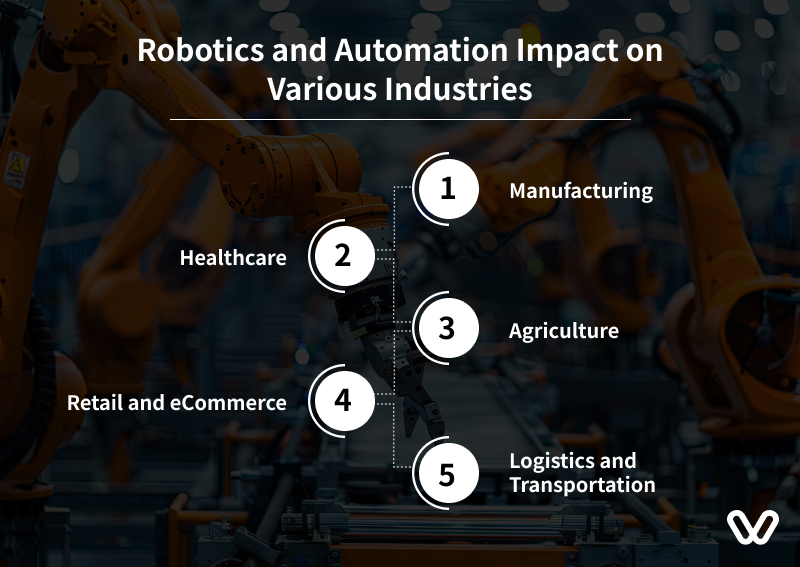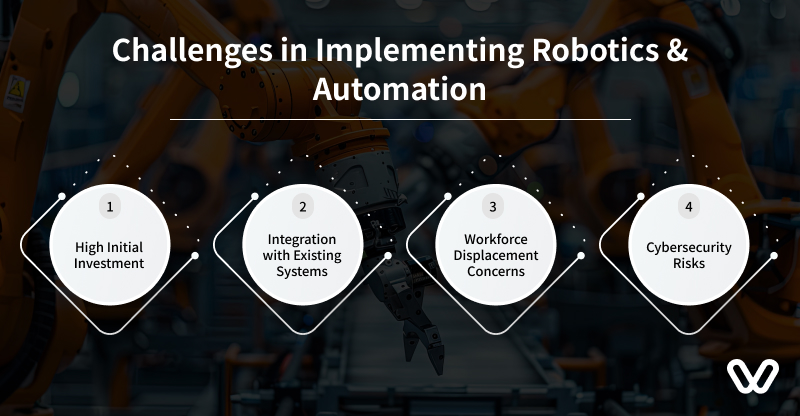Tired of your business falling behind the competition?
As technology advances, traditional operating methods are becoming outdated and inefficient. Manual procedures not only slow down but also increase the risk of expensive mistakes and delays.
It’s not just a suggestion but a necessity to modernize your company and embrace the future.
That’s when you can choose robotics and automation, as it helps you improve productivity, decrease human error, and streamline processes in your business.
But how can robotics and automation trends help?
Read our blog on the future of robotics and automation to understand and grow your business to new heights.
Key Benefits of Robotics and Automation
The growth of industrial automation & robotics provides several key benefits that promote operational excellence and corporate expansion. Here are a few main benefits of robotics automation trends:
1. Increase Efficiency and Productivity: Trends in robotics and automation greatly increase production and efficiency by optimizing processes and reducing time spent on tedious work. Automated systems can operate without getting tired, guaranteeing constant output and reducing downtime.
For example, robotic arms can build goods more precisely and quickly than human workers, resulting in increased output rates and better consistency.
2. Cost Savings and Labor Reduction: Robotics and automation can save significant money by reducing the need for human labor. Labor expenses are reduced as automated systems handle jobs that would otherwise need many shifts of human workers. It reduces human error and the waste and rework expenses that come with it.
For example, automated systems for sorting and packing products in warehouses may manage high product volumes more effectively, minimizing the need for a big manual staff.
3. Enhanced Precision and Accuracy: Robotics automation trends offer unmatched accuracy and precision in task execution. There is less room for error and the finished product is of higher quality as robotics in industries can carry out tasks to precise specifications.
For example, robotic-assisted surgeries in the medical field allow surgeons to execute intricate procedures with extreme precision, improving patient outcomes and minimizing problems.
4. Improved Safety and Reduced Workplace Hazards: Automation reduces the risk of workplace accidents and injuries by taking over physically taxing and dangerous jobs. Robots can conduct heavy lifting, manage harmful products, and work in dangerous locations, keeping human workers safe.
For example, automated equipment in the construction sector can manage excavation and demolition tasks, lowering the risk to human workers.
5. Flexibility and Scalability in Operations: Exceptional scalability and adaptability trends in robotics and automation let firms quickly adjust to shifting market demands and production needs. Automated systems make it easy to scale up or down operations as needed since they are quickly reprogrammed or altered to handle new jobs.
For example, automated inventory management solutions in the retail sector ensure optimal stock levels and effective supply chain management by promptly adapting to variations in product demand.
Impact of Robotics and Automation on Various Industries
Robotics automation trends are transforming various industries by providing creative solutions that improve efficiency, productivity and overall business performance. Here are some of the impacts of robotics and automation in industries:
1. Manufacturing
Automation and robotics in manufacturing are transforming production processes by boosting accuracy, speed, and efficiency. Robotic welding, automated assembly lines, and precise machining are examples of how these technologies simplify operations.
For example, automakers use robots to complete jobs like painting, assembling, and quality control, which speeds up production cycles, lowers labor costs, and reduces errors.
2. Healthcare
Automation and robots are bringing about breakthroughs in the healthcare sector. Robotic surgery provides highly accurate, minimally invasive operations that shorten recovery periods and enhance patient outcomes. Automation improves accuracy and speeds up procedures in laboratory testing and diagnostics.
For example, robotic-assisted surgery systems, such as the da Vinci Surgical System, improve patients’ and healthcare providers’ control and precision in complex procedures performed by surgeons.
3. Agriculture
Automation and robots in agriculture solve issues like labor scarcity and the requirement for sustainable methods. Automated crop monitoring, planting, and harvesting systems increase efficiency and productivity. Self-driving tractors and drones make it easier for farmers to oversee vast areas.
For example, automated harvesting robots can select produce more quickly and precisely than human labor, lowering waste and guaranteeing timely harvests.
4. Retail and eCommerce
Automation and robots significantly impact AI in the retail and eCommerce industries by facilitating faster order fulfillment, better inventory management, and better customer experiences. Robots are used in automated warehouses and fulfillment centers to package, sort, and ship goods.
For example, Amazon’s deployment of Kiva robots in its warehouses has significantly lowered order processing times and improved storage effectiveness, allowing customers to receive their orders more quickly.
5. Logistics and Transportation
Future of Robotics and automation are revolutionizing logistics and transportation by increasing efficiency and streamlining supply chain processes. Drones, automated sorting systems, and self-driving cars simplify the transportation of products.
For instance, automated guided vehicles (AGVs) minimize delays and the requirement for human involvement in the efficient transportation of items in warehouses. Self-driving trucks are being developed in the transportation industry to lower the expenses and dangers of long-haul shipping.
Common Challenges in Implementing Robotics & Automation
Implementing robotics and automation in different industries provides several challenges and solutions to ensure successful integration and operation. Let’s discuss some challenges that occur with the rise of AI:
1. High Initial Investment
Challenge: One main challenge is the high initial investment required to acquire and configure robotic and automated equipment. This expense may be unaffordable, particularly for small and medium-sized businesses (SMEs).
Solution: To address this, companies should consider funding solutions like equipment leasing, grants, or tax breaks to promote technology adoption. Moreover, launching a pilot project might assist in proving the ROI and obtaining further financing for wider adoption.
2. Integration with Existing Systems
Challenge: Integrating new robotic systems with the current infrastructure might be difficult and time-consuming. Many challenges may exist, such as the need to retrain employees to use new technology and compatibility problems.
Solution: These problems can be lessened by carefully analyzing the current systems and organizing a gradual integration. Middleware solutions that span multiple technologies can be utilized for a more seamless integration process.
3. Workforce Displacement Concerns
Challenge: The advent of automation frequently concerns job displacement and the workforce’s influence. Employee resistance and low morale may result from their fear of having their work taken over by machines.
Solution: Employers can address these issues by emphasizing staff reskilling and upskilling. Easing the transition can be achieved by providing training programs that let staff members use and manage emerging tech trends.
4. Cybersecurity Risks
Challenge: As they become more networked, the growth of industrial automation and robotics systems is more susceptible to hacks. Unauthorized access to or manipulation of automated systems can result in data breaches, business interruptions, and safety risks.
Solution: Strengthening cybersecurity safeguards is critical. This involves implementing strong encryption procedures, regularly upgrading software, and conducting frequent security assessments.
Conclusion
Robotics automation trends together promise a bright future. The future of AI promises to raise productivity, enhance quality of life, and potentially answer some of the planet’s most pressing problems.
However, we must utilize it carefully, considering what we should and can achieve, just like we would with any powerful tool.
There’s no denying that the future of robotics and automation will not just be about machines. Whether it is a world where robots serve as our instructors, friends, or coworkers. It’s about the potential for bright futures that arise from the coexistence of people and technology.



